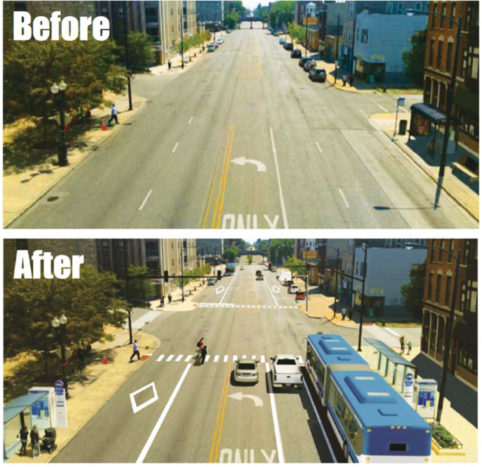
Construction is expected to start in 2018 on the 15L Route Improvements Project that will include new larger, more attractive bus shelters.
Editor’s Note: This is the third in a series of three articles prepared by the Front Porch on transit-oriented development (TOD) sites in NE Denver.
Transit oriented development (TOD) along Colfax is an entirely different proposition than what is found at the Fitzsimons Parkway light rail or Central Park commuter rail stations. For starters, the corridor is not a newly developing area. It hosts 150,000 of Denver’s 680,000 residents, it is the most heavily used bus route in the RTD system, and there isn’t much vacant land available. Increasing capacity and creating a successful TOD along Colfax will be a gradual multi-pronged process.
As transit service improves on Colfax between downtown and the Anschutz Fitzsimons campus, redevelopment pressure will increase. With that pressure will come negatives as well as positives. Greater densities and mix of uses can displace some residents and small businesses as property values and rents increase.

Colfax is shown above as it looks now and below with exclusive lanes for bus rapid transit. Denver is working on an application for federal funds to support the implementation of this project. The source of $50 million in matching funds from Denver is unknown at this time.
Beginning in April, Denver is embarking on a federally funded “TOD Implementation Plan” to identify infrastructure needs that would help make Colfax a “walkable main street.” TOD, the term used to describe dense, walkable development around high-frequency transit stations, is a key element of the city’s economic development strategy. The new plan will develop strategies to avoid displacement while encouraging new investment in the area. The $1.8 million project is expected to take 18 to 24 months.
Another step toward improving transit on Colfax, the 15L Route Improvements Project, is nearing the end of its preliminary design phase. This RTD project aims to improve the rider experience and accelerate bus travel times on the 15 Limited (the high-frequency bus service that runs on Colfax between Broadway and I-225) with the following physical and operational improvements:
- New bus shelters that are larger, more attractive, lighted and equipped with security cameras.
- More trash cans and benches.
- Bus bulbs (curb extensions) at some stops providing more waiting space for passengers and speeding up bus operations.
Queue bypass lanes at four locations where the bus typically gets delayed by congestion (the bus can share a right turn-only lane).
Transit signal priority (TSP) at many of the Denver intersections enabling the bus to get an earlier or longer “green” signal.
Project manager Lacy Bell of RTD says the 15L project has an $11 million budget and construction is expected to begin in 2018.
Bell says all of the planned improvements will be compatible with what is expected to be the following phase in Colfax mass transit enhancements: bus rapid transit (BRT). A joint Denver-Aurora study, began with a simple but daunting problem statement: how does this high-frequency bus corridor accommodate a 20 to 30 percent increase in person trips by 2025 without expanding the roadway?
Having examined everything from streetcars to monorails, Denver settled on BRT that runs the length of the corridor and has exclusive lanes between Broadway and Syracuse during the extended morning and afternoon rush hours. BRT features include high-frequency (every five minutes), low-level boarding, real-time bus arrival information and the ability to purchase tickets before boarding, greatly reducing bus “dwell” time at the curb.
Denver is working on an application for federal funds to support the implementation of such a BRT project. Currently unanswered questions about BRT are whether Denver or RTD would operate this $135 million system and the source of funds for a Denver match of $50 million or more.

The Bus Rapid Transit corridor will run from the Auraria compus downtown to the Anschutz Medical Campus.
Denver’s TOD manager, Chris Nevitt, believes the TOD Implementation Plan “would definitely help Denver get into a position to receive federal funds for the BRT,” but he emphasizes it is not for planning infrastructure. It is to harmonize land use, economic development and infrastructure plans and address impacts on low-income residents and low-revenue businesses that might be displaced.
One reason Denver decided to undertake this planning project stems from developers’ perception of BRT as compared with rail transit. Quoting from Denver’s application to the Federal Transit Administration: “The East Colfax Corridor is particularly important to conduct comprehensive TOD planning because, unlike rail projects, empirical evidence shows that BRT does not attract large scale TOD in the same way as light rail. Convincing developers to invest in TOD projects at station areas along Colfax will take careful planning and investment of significant resources by Denver to create the market for TOD.”
Just as improvements to transit service are being made step by step, redevelopment near transit stops along Colfax will occur incrementally.
Visit FrontPorchStapleton.com to read the prior two TOD articles: “A Line Train Stimulates Central Park TOD” (December 2016) and “R Line Bringing Development to Fitzsimons” (November 2016).



0 Comments